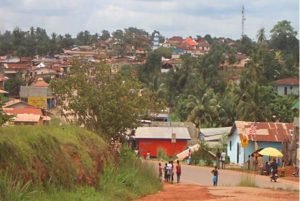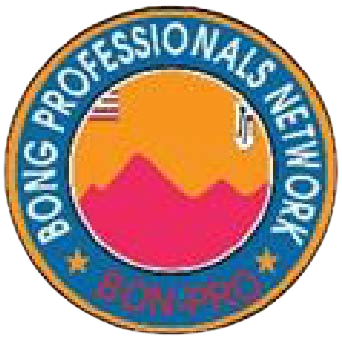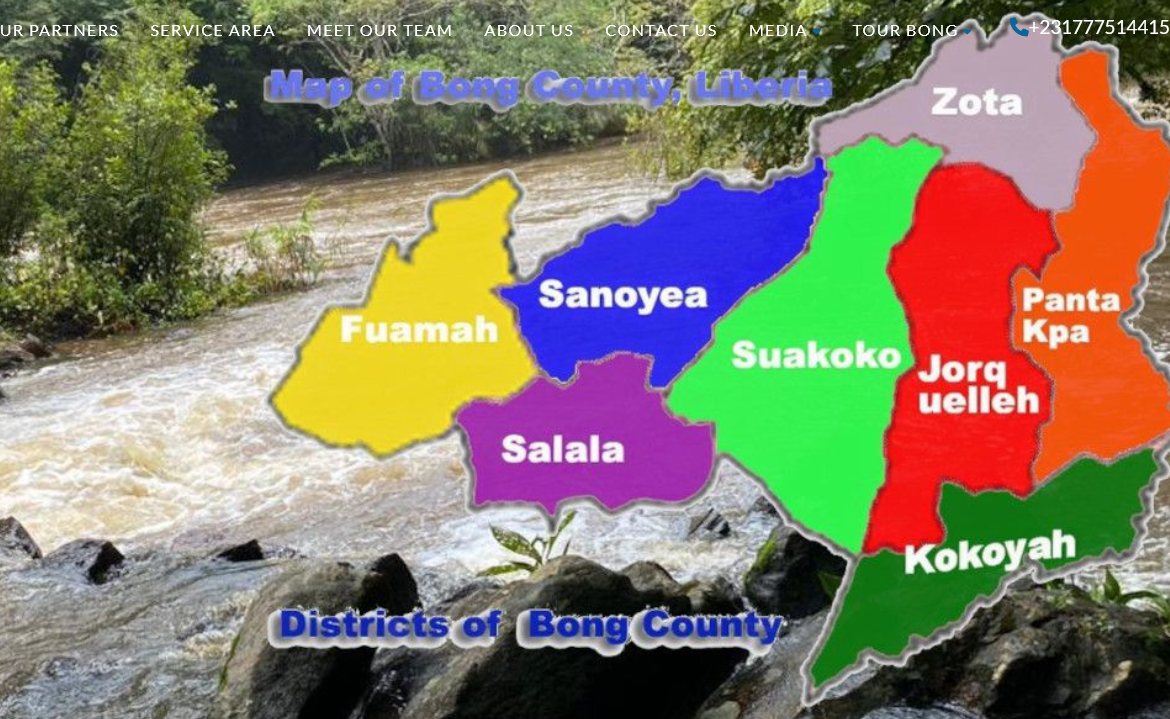DISTRICTS OF BONG COUNTY
- Jorquelleh: Known for its agricultural activities.
- Sanoyea: Recognized for its diverse cultural heritage.
- Zota: Features prominent natural landscapes.
- Salala: Focuses on trade and market activities.
- Suakoko: Hosts major educational institutions.
- Fuamah: Rich in mining activities.
- Kokoyah: Known for its traditional practices.
Bong is a county in the north-central portion of the West African nation of Liberia established in 1964.
Bong was named after Bong Range Mountain in the northeast-southern direction at elevations averaging from 600 to 1,000 feet (180- 300m) its highest point, however, is 2,116 feet.
During the mid-1960s its iron-ore deposits have been worked by the German-Liberia Mining Corporation (Delimco) and shipped via the company railroad to the port of Monrovia (50 miles southwest). In 2010, China Union took over mining activities at the Bong range previously operated by the Germans who quit mining activities as the result of the civil conflict which broke out in December 1990.
The two geographical instruments in the white field portion of the flag symbolize Bong County’s mining industry. The county’s flag is purple, signifying the dawn, and orange, signifying the county’s newness. It was created in 1964, along with Nimba, Lofa and Grand Gedeh, when the administrative sub-divisions of Liberia were increased to a total of thirteen.
The capital is Gbarnga, named after an old farm in the location. It is one of 15 counties that comprise the first-level of administrative division in Liberia, it has twelve administrative districts. Gbarnga serves as the capital.

Geography:
he county was organized in 1964 and is important for its mining industry.
It is bordered by Lofa and Gbarpolu counties to the north, Margibi and Montserrado counties to the west, Grand Bassa County to the south, and Nimba County to the east.
The northeast part of Bong borders the nation of Guinea. Bong County current Superintendent is Esther Y. Walker.
The flag of Bong County is orange and purple with a hammer in the background as a reference to the traditional importance of mining to the local economy.
Bong County is situated in the central part of The main paved road that runs from Monrovia to Sanniquellie in Nimba County traverses Bong County.

Until 1964, present day Bong County was a part of Liberia known as the Central Province. The civil conflict was particularly cruel to Bong County, parts of which were contested by multiple militias over fourteen years, resulting in massive losses of life and egregious human rights abuses, especially perpetrated against women and girls. Bong County served for a time as the capital of would-be president Charles Taylor’s “Greater Liberia”, and the area provided perhaps a majority of the children and young women that were forced to join the various fighting forces. Most of the County’s public infrastructure and private property was looted or destroyed. While the situation has improved since the election in 2005 Government and the arrival of international peacekeepers, multilateral agencies and NGOs, there is still a dangerously high unemployment rate and a need for urgent improvements in health, education, and all sectors of the economy. It’s home to government offices, educational institutions, and a vibrant market where locals gather to trade goods. As of today, in Gbarnga live 26122 women.
Until 1964, present day Bong County was a part of Liberia known as the Central Province. The civil conflict was particularly cruel to Bong County, parts of which were contested by multiple militias over fourteen years, resulting in massive losses of life and egregious human rights abuses, especially perpetrated against women and girls. Bong County served for a time as the capital of would-be president Charles Taylor’s “Greater Liberia”, and the area provided perhaps a majority of the children and young women that were forced to join the various fighting forces. Most of the County’s public infrastructure and private property was looted or destroyed. While the situation has improved since the election in 2005 Government and the arrival of international peacekeepers, multilateral agencies and NGOs, there is still a dangerously high unemployment rate and a need for urgent improvements in health, education, and all sectors of the economy. It’s home to government offices, educational institutions, and a vibrant market where locals gather to trade goods. As of today, in Gbarnga live 26122 women.
As of today, in Gbarnga 6795 little kids. Of these boys – 3465 and girls 3329. These are children from 5 to 9 years old. Today in Gbarnga there are 6270 children. Of these, the boys are – 3197 and girls – 3073. These are children from 10 to 14 years old. Today in Gbarnga living 5710 teenagers. These are people from 14 to 19 years old. Of these, the girls are – 2804, boys – 2905

PEOLE OF BONG COUNTY
Ethnic Diversity:
Bong County is home to a mix of ethnic groups, with the Kpelle being the largest and most prominent. Other ethnic groups present in the county include the Gbandi, Mano, Mandingo, and Loma, among others. This ethnic diversity contributes to a culturally rich and diverse society.
Language:
The primary language spoken in Bong County is Kpelle, although English is also widely understood and used, especially in formal settings and education.
Traditions and Customs:
Bong County residents uphold various traditional customs and practices that have been passed down through generations. These customs often include ceremonies, dances, and rituals that play a significant role in their social and religious lives.
Religion:
The people of Bong County practice a mix of religions, with a significant portion adhering to Christianity, Islam, and traditional African beliefs. Religious tolerance and coexistence are notable features of the county
Livelihood:
Agriculture is a central part of the livelihoods of Bong County residents. The county’s fertile soil supports the cultivation of various crops, including rice, cassava, cocoa, and coffee. Additionally, some engage in small-scale mining and trade.
Community and Social Bonds:
Bong County communities are characterized by strong social bonds and a sense of communal living. Traditional leaders play an important role in maintaining social order and resolving disputes.
Resilience:
The people of Bong County have faced their share of challenges, including the civil conflicts that affected Liberia. Despite these difficulties, they have demonstrated remarkable resilience and a determination to rebuild their communities and lives.
Hospitality:
Bong County residents are known for their warm hospitality and welcoming nature. Visitors to the county often find themselves embraced by the local communities, experiencing the generosity and friendliness of the people. The people of Bong often welcome visit with kola-nut.
Cultural Heritage
The county is home to a rich cultural heritage, with traditional music, dance, and storytelling which including oral history being important aspects of the local culture. These cultural expressions are often used to convey history, values, and community identity
Economic Activities:
In addition to agriculture and mining, residents of Bong County engage in various economic activities, including small businesses, trade, and craftsmanship. Markets in the county are lively centers of commerce. Some of the economic activities include local markets, hotels, guest houses, substance farming, cultivation of land and trades in general.
Geography:
Bong County encompasses a wide range of geographical features, including rolling hills, lush forests, fertile farmland, and numerous rivers and streams. The county’s topography contributes to its agricultural significance.
Agricultural Land:
The fertile soils of Bong County make it a major agricultural hub in Liberia. It is known for the cultivation of crops such as rice, cassava, cocoa, coffee, and various vegetables. Agriculture is a primary livelihood for many residents.
Bong Range
The Bong Range is a prominent geographical feature in the county, consisting of a series of forested hills and mountains. The Bong Range Forest Reserve is known for its biodiversity and is home to various wildlife species.
River Network:
Bong County is intersected by several rivers and waterways, including the St. Paul River, the Mani River, and the Bong Mine River, and Jor River, Farmington River, St John River, . These rivers not only provide water for agriculture but also serve as transportation routes. These rivers also serve fishing and irrigation purposes.
Gola Forest:
Part of the Gola Forest is in Bong County. This forest is a UNESCO World Heritage site and is known for its rich biodiversity, including numerous species of birds, mammals, and plants
Cultural Diversity:
Bong County is home to a diverse population representing various ethnic groups, including the Kpelle, Gbandi, Mano, Mandingo, and Loma, among others. This diversity contributes to a rich tapestry of cultures, traditions, and languages.
Gbarnga:
Gbarnga is the capital city of Bong County and serves as an administrative, commercial, and educational center. It is home to government offices, markets, educational institutions, and healthcare facilities. The population of Gbarnga is estimated at 3,436 people.
Educational Institutions:
Bong County boasts several educational institutions, including Cuttington University, one of Liberia’s oldest and most prestigious universities. These institutions play a significant role in the county’s development and educational advancement. The county also boasts of several technical institutions including Bong Technical College, Gbarnga Theological College and more.
Agricultural Projects:
Various agricultural projects and initiatives aimed at improving farming practices and increasing food security are active in Bong County. These projects help local farmers adopt modern and sustainable agricultural techniques. The following is a list if some major Agricultural projects in the county: Central Agricultural Research Institute (CARI) the county’s major agricultural resource center, is located in Suakoko including several other agricultural projects.
Traditional Practices:
Bong County is known for preserving traditional customs and practices. Traditional leaders and cultural events, such as ceremonies, dances, and rituals, are essential aspects of the local culture. There are two major tradition society practiced in the county. They are the PORO and SANDE Societies. The PORO is mainly practiced by the men and Sande is practiced by the women. One of Bong County’s strongest traditions is inter-marriages.
Historical Significance:
Bong County has historical significance due to its role in the iron ore mining industry during the mid-20th century. The remnants of Bong Mines, an old mining town, are still visible. Bong county has a lasting history in gold mining, rubber, timbers and can be traced as far back in the mid-20th century. Some of the early start-ups mining companies include the BONG MINING COMPANY (BMC) which began operation in 1958. In 2009, China Union took over BMC and is in still operation today.
Community Spirit:
Communities in Bong County are known for their strong social bonds and communal living. Residents often come together to support each other in various aspects of life. Families often come together, looking after one another and seeking each other’s welfare. They unite to solve problems affecting them and their communities.
Wildlife and Conservation:
The county is home to a variety of wildlife, including different bird species, primates, and other animals. Efforts are made to promote wildlife conservation and eco-tourism. Some of the county’s wildlife include Elephants, Tigers, Chimpanzees, Monkeys, Leopards, Hippopotamus and Lions.
Bong County’s combination of natural beauty, cultural diversity, and historical significance makes it a unique and significant region within Liberia. It continues to evolve while maintaining its traditions and embracing modern developments.




